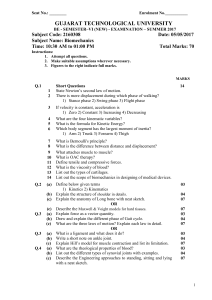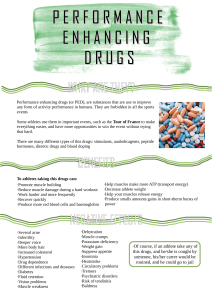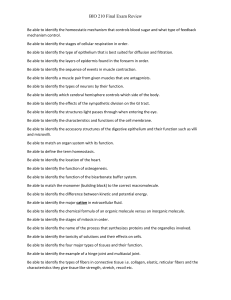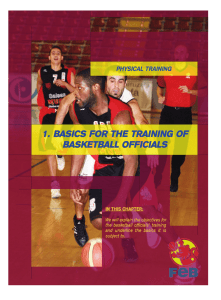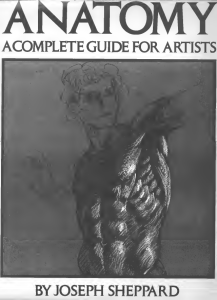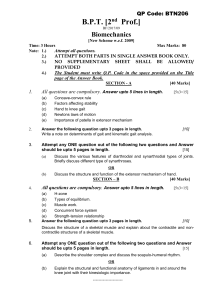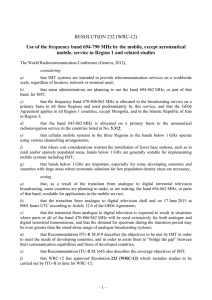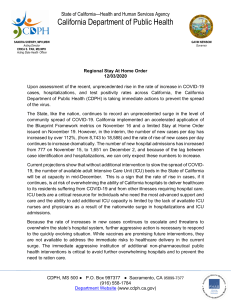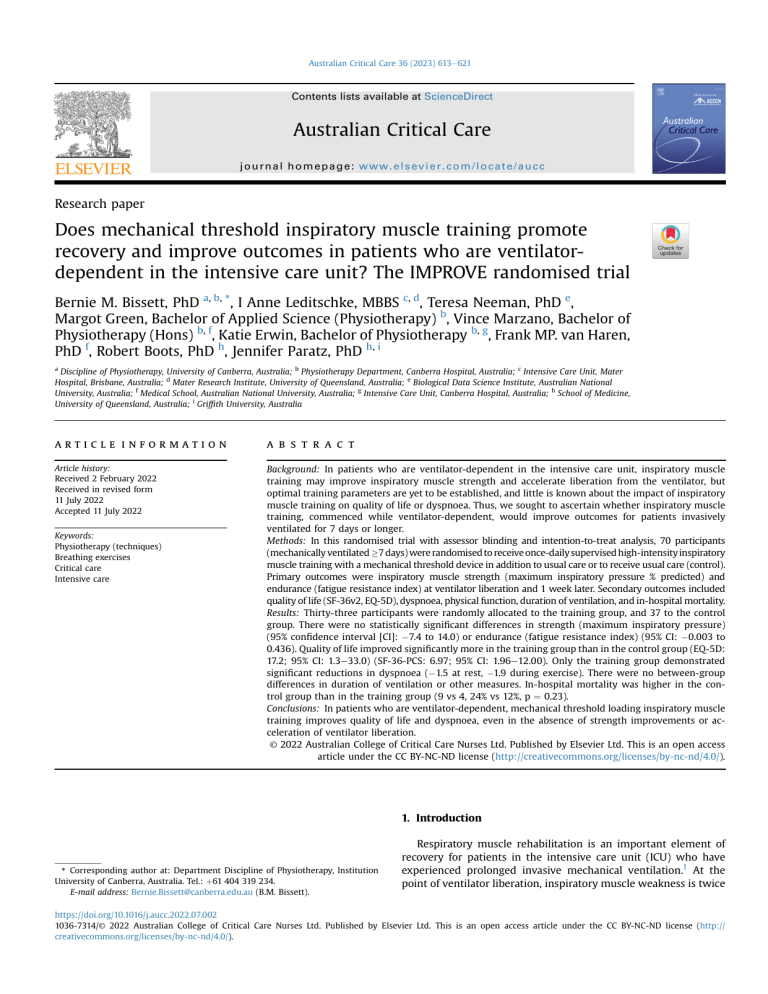
Australian Critical Care 36 (2023) 613e621 Contents lists available at ScienceDirect Australian Critical Care journal homepage: www.elsevier.com/locate/aucc Research paper Does mechanical threshold inspiratory muscle training promote recovery and improve outcomes in patients who are ventilatordependent in the intensive care unit? The IMPROVE randomised trial Bernie M. Bissett, PhD a, b, *, I Anne Leditschke, MBBS c, d, Teresa Neeman, PhD e, Margot Green, Bachelor of Applied Science (Physiotherapy) b, Vince Marzano, Bachelor of Physiotherapy (Hons) b, f, Katie Erwin, Bachelor of Physiotherapy b, g, Frank MP. van Haren, PhD f, Robert Boots, PhD h, Jennifer Paratz, PhD h, i a Discipline of Physiotherapy, University of Canberra, Australia; b Physiotherapy Department, Canberra Hospital, Australia; c Intensive Care Unit, Mater Hospital, Brisbane, Australia; d Mater Research Institute, University of Queensland, Australia; e Biological Data Science Institute, Australian National University, Australia; f Medical School, Australian National University, Australia; g Intensive Care Unit, Canberra Hospital, Australia; h School of Medicine, University of Queensland, Australia; i Griffith University, Australia article information a b s t r a c t Article history: Received 2 February 2022 Received in revised form 11 July 2022 Accepted 11 July 2022 Background: In patients who are ventilator-dependent in the intensive care unit, inspiratory muscle training may improve inspiratory muscle strength and accelerate liberation from the ventilator, but optimal training parameters are yet to be established, and little is known about the impact of inspiratory muscle training on quality of life or dyspnoea. Thus, we sought to ascertain whether inspiratory muscle training, commenced while ventilator-dependent, would improve outcomes for patients invasively ventilated for 7 days or longer. Methods: In this randomised trial with assessor blinding and intention-to-treat analysis, 70 participants (mechanically ventilated 7 days) were randomised to receive once-daily supervised high-intensity inspiratory muscle training with a mechanical threshold device in addition to usual care or to receive usual care (control). Primary outcomes were inspiratory muscle strength (maximum inspiratory pressure % predicted) and endurance (fatigue resistance index) at ventilator liberation and 1 week later. Secondary outcomes included quality of life (SF-36v2, EQ-5D), dyspnoea, physical function, duration of ventilation, and in-hospital mortality. Results: Thirty-three participants were randomly allocated to the training group, and 37 to the control group. There were no statistically significant differences in strength (maximum inspiratory pressure) (95% confidence interval [CI]: 7.4 to 14.0) or endurance (fatigue resistance index) (95% CI: 0.003 to 0.436). Quality of life improved significantly more in the training group than in the control group (EQ-5D: 17.2; 95% CI: 1.3e33.0) (SF-36-PCS: 6.97; 95% CI: 1.96e12.00). Only the training group demonstrated significant reductions in dyspnoea (1.5 at rest, 1.9 during exercise). There were no between-group differences in duration of ventilation or other measures. In-hospital mortality was higher in the control group than in the training group (9 vs 4, 24% vs 12%, p ¼ 0.23). Conclusions: In patients who are ventilator-dependent, mechanical threshold loading inspiratory muscle training improves quality of life and dyspnoea, even in the absence of strength improvements or acceleration of ventilator liberation. © 2022 Australian College of Critical Care Nurses Ltd. Published by Elsevier Ltd. This is an open access article under the CC BY-NC-ND license (http://creativecommons.org/licenses/by-nc-nd/4.0/). Keywords: Physiotherapy (techniques) Breathing exercises Critical care Intensive care 1. Introduction * Corresponding author at: Department Discipline of Physiotherapy, Institution University of Canberra, Australia. Tel.: þ61 404 319 234. E-mail address: Bernie.Bissett@canberra.edu.au (B.M. Bissett). Respiratory muscle rehabilitation is an important element of recovery for patients in the intensive care unit (ICU) who have experienced prolonged invasive mechanical ventilation.1 At the point of ventilator liberation, inspiratory muscle weakness is twice https://doi.org/10.1016/j.aucc.2022.07.002 1036-7314/© 2022 Australian College of Critical Care Nurses Ltd. Published by Elsevier Ltd. This is an open access article under the CC BY-NC-ND license (http:// creativecommons.org/licenses/by-nc-nd/4.0/). 614 B.M. Bissett et al. / Australian Critical Care 36 (2023) 613e621 as prevalent as peripheral ICU-acquired weakness.2 However, with a multidisciplinary approach involving nursing, medical, and physiotherapy staff, specific inspiratory muscle training (IMT) is both safe and feasible for patients in the ICU.3 Although yet to be confirmed in critically unwell patients, the likely mechanisms of improvement with IMT include enhanced efficiency of both the diaphragm4 and intercostal muscles,5 as well as modulation of the metaboreflex associated with diaphragm fatigue,6 whereby with training, perfusion is redistributed peripherally to facilitate more exercise tolerance.7 A recent systematic review and meta-analysis concluded that IMT accelerates liberation from mechanical ventilation more so than conventional physical therapy.8 However, there remains considerable heterogeneity in approaches to IMT in the ICU.1,9 While a multidisciplinary approach appears crucial, the ideal training parameters and techniques are yet to be established.1 Mechanical spring-loaded threshold devices have been used to strengthen inspiratory muscles in patients recently weaned from mechanical ventilation. A supervised daily high-intensity strengthening regimen (30 breaths at a minimum 50% maximum inspiratory pressure) improved patients’ inspiratory muscle strength and quality of life within 2 weeks.10 While this high-intensity approach to IMT is safe in selected ventilator-dependent patients (i.e., those who are alert and able to participate in training, with positive endexpiratory pressure (PEEP) <15 cmH2O, FiO2<0.60),11 it is not yet clear whether these patients would gain similar benefits from commencing training prior to ventilator liberation. Previous studies of threshold-based IMT in ventilatordependent patients have been limited by restrictive sampling (e.g., excluding patients younger than 70 years or those with a tracheostomy;12 only targeting patients with chronic obstructive pulmonary disease (COPD),13 or insufficient loading (e.g., 30%14 or 40%15 maximum inspiratory pressure). One recent randomised trial of high-intensity threshold-based IMT failed to detect improvements in inspiratory muscle strength or ventilation duration;16 however, this study did not measure the effect of training on other patient-centred outcomes such as quality of life or dyspnoea. Given the previous significant improvements in quality of life in patients in the ICU with just 2 weeks of IMT,10 and the need to shift focus to a more patient-centred approach in ICU research, the impact of IMT on quality of life requires further investigation in ventilator-dependent patients. Thus, the objectives of our study were to establish if highintensity IMT, using a mechanical threshold loading device, would improve not just inspiratory muscle strength but also patient-centred outcomes (including quality of life, dyspnoea, and physical function) in a heterogeneous sample of patients who were ventilator-dependent for 7 days or longer. 2. Methods 2.1. Study design In accordance with our prepublished protocol,17 we conducted this investigator-initiated single-centre randomised controlled trial using concealed allocation, assessor blinding, and intention-totreat analysis to compare IMT with usual care in patients who were ventilator-dependent in the ICU for at least 7 days. The study was approved by the Australian Capital Territory Health Human Research Ethics Committee (ETH.10.10.370) and the University of Queensland Medical Research Ethics Committee (2010001498). The published protocol17 (trial registration ACTRN12610001089022) complied with the CONSORT guidelines for clinical trials.18 Patients were eligible for inclusion if they had been invasively mechanically ventilated (via endotracheal tube or tracheostomy) for at least 7 days, were aged 16 years, and were sufficiently alert to provide informed consent and participate actively in training (Riker SedationeAgitation Scale19 score of 4). Exclusion criteria included pregnancy, significant pain or distress affecting breathing, medical instability (e.g., new cardiac arrhythmia, acutely septic) where the treating team considered that interference with ventilatory support could compromise the patient's recovery,17 or anticipated death within weeks. All participants provided written consent to participate in the study. The study was conducted in a 31-bed Australian mixed-medical/ surgical/trauma ICU where minimal sedation and early rehabilitation20 are well established. The medical officers making ventilator liberation decisions were blinded to group allocation. Training was conducted by physiotherapists in line with our previously published protocol, which is safe and feasible in ventilator-dependent patients.11 Due to the nature of the supervised training, therapists could not be blinded to group allocation. 2.2. Intervention Using a computer-generated random number sequence (with concealed allocation), participants were randomised to usual care (control group) or IMT in addition to usual care (IMT group). Usual care included secretion clearance techniques (e.g., percussion, hyperinflation, suction) but did not include inspiratory resisted breathing of any kind. The IMT device used was the Threshold inspiratory muscle trainer (Threshold IMT device HS730, Respironics NJ, USA). This spring-loaded one-way valve provides titratable inspiratory resistance in a range of 9e41 cmH2O and can readily be connected to an endotracheal tube or tracheostomy (Fig. 1). For training, a high-intensity low-repetition method was used as previously described.1,3,10 Intensity was prescribed at a minimum of 50% of maximal inspiratory pressure (MIP) at the highest tolerable intensity where the participant could just complete the sixth breath in a set of six breaths. One treatment session consisted of five sets of six breaths, where resistance was increased between sets as appropriate. Participants were returned to the ventilator between sets, where they typically required only a few minutes’ rest. Training commenced following randomisation and continued once daily (weekdays only) until 1 week following successful liberation from mechanical ventilation (defined as 24 h without positive pressure). We did not use a sham device for comparison due to the risk of a sham device providing a training stimulus in participants with very low inspiratory muscle strength.21 2.3. Measures 2.3.1. Primary outcomes Primary outcomes were measured by specifically trained research nurses blinded to group allocation. Initial measurements were conducted following enrolment and prior to randomisation; interim measurements were obtained following successful liberation from the ventilator (24 h spontaneously breathing without positive pressure); and final measurements were recorded 1 week following liberation. Inspiratory muscle strength (MIP) was measured from residual volume using a portable MicroRPM Respiratory Pressure meter (CareFusion, San Diego, USA) in accordance with the protocol described by the American Thoracic Society and European Respiratory Society.22 This device has excellent reliability (intraclass correlation: 0.83e0.90).23 Following successful ventilator liberation, inspiratory muscle fatigue was measured using the fatigue resistance index (FRI) previously described in ICU survivors.24 This technique, based on the maximum incremental threshold loading test,25 requires participants to breathe against 30% resistance for 2 min, and MIP B.M. Bissett et al. / Australian Critical Care 36 (2023) 613e621 615 previous studies of ICU survivors.24,31 Raw MIP scores were normalised32 to account for variations of MIP with age and gender. Paired t-tests were used to compare within-group differences. Mixed linear models were used to assess the between-group difference of the changes between enrolment and follow-up measures, including age, gender, APACHE II scores, and ‘ventilation time prior to randomisation’ as covariates. Diagnostic plots (predicted means versus Pearson's residuals) were generated to assess model assumptions. Mortality and reintubation data were analysed using Fisher's exact test. Post-ICU length of stay was analysed using a Wilcoxon rank-sum test, with exclusion of patients who died in hospital. Statistical significance was set as p < 0.05. All analyses were completed using R 3.6.1.1 3. Results Fig. 1. Attachment of threshold inspiratory muscle trainer to endotracheal tube. measures before and after the loading test are compared. The FRI was also measured 1 week following successful ventilator liberation. 2.3.2. Secondary outcomes Participants’ quality of life was measured on enrolment and completion (1 week following ventilator liberation) by research nurses blinded to group allocation. Quality of life was measured using both the SF-36v2 tool (acute 1 week time frame) (under licence QualityMetric, USA) and the EQ-5D-3L tool (under licence EuroQol International). The SF-36 is reliable, is responsive, and has both construct and criterion validity in intensive care patients.26 The EQ-5D-3L tool has been used extensively in follow-up of patients who survived the ICU27 and gives a more general measure of health-related quality of life than the SF-36. Dyspnoea was measured using a Modified Borg Dyspnoea Scale, where dyspnoea is a patient-reported categorical score out of 10. This scale has acceptable reliability and validity in patients undergoing mechanical ventilation.28 Dyspnoea was recorded both at rest (sitting comfortably in the chair or bed) and during exercise (the peak exercise activity experienced in the previous 24 h) by research nurses blinded to group allocation, at both enrolment and study completion. Physical function was assessed using the Acute Care Index of Function (ACIF).29 This tool captures mental status, bed mobility, transfers, and mobility and has excellent inter-rater reliability in patients in the ICU (intraclass correlation ¼ 0.94).30 On enrolment, ACIF scores were completed by ICU physiotherapists prior to randomisation (thus blinded to group allocation); however, follow-up ACIF scores were recorded by the ward physiotherapist who was not blinded. Other outcomes extracted from the hospital databases included the number of training sessions (intended and completed), any requirement for reintubation, duration of mechanical ventilation, duration of pressure support ventilation, ICU length of stay, postICU hospital length of stay, and in-hospital mortality. 2.4. Data analysis The sample size was calculated a priori for the primary outcome measures (MIP). To detect a 10% change in MIP with a power of 0.80, 70 participants were required (inflating group size by 15% due to anticipated mortality of 12.8%17). In the absence of an established minimal clinically important difference in MIP in patients in the ICU, the 10% level was selected to facilitate comparison with The flow of participants is presented in Fig. 2. Between February 2011 and June 2019, 70 participants were recruited to participate in the study, with 33 allocated to the IMT group and 37 to the control group. The most frequent reason for exclusion from the study was low neurological status (low Glasgow Coma Score) with inability to provide consent. Five participants were lost to follow-up in the IMT group, and 10 in the control group, most commonly due to death (either during the ICU admission or following discharge on the ward). The total ICU mortality for the cohort was 10% (7/70), while the total in-hospital mortality was 18.5% (13/70). Where patients were lost to follow-up regarding the primary outcome measures, but for reasons other than death, secondary measures were obtained through hospital databases and telephone interviews where possible. Groups were generally comparable at baseline, and participant characteristics on enrolment are presented in Table 1. 3.1. Compliance with trial protocol In the IMT group, the 33 participants completed a median of eight sessions of IMT during the study (range: 2e67). Participants completed 71% of all intended IMT sessions (range: 27%e100%). While 19 (58%) participants completed more than 70% of the prescribed IMT sessions, two (6%) participants completed 30% or less of the prescribed IMT sessions. The most frequent reason for lack of completion was participant refusal due to generalised fatigue, followed by confusion or drowsiness rendering them temporarily unable to participate. IMT was generally well tolerated, and no adverse effects were reported during or immediately after training in any participant. No participants in the control group inadvertently received IMT. 3.2. Effect of intervention Changes in outcome measures within and between groups are summarised in Table E1 and Table 2, respectively. Both the IMT group and the control group had significantly increased MIP scores (% of predicted) across the study period (14.7 and 11.4%, respectively) (Fig. 3a and Table 2); however, the IMT group failed to demonstrate a significant increase from baseline to ventilator liberation, indicating that the majority of their improvements occurred in the final week between liberation and completion (10.1%). There was no statistically significant difference between 1 R Core Team (2022). R: A language and environment for statistical computing. R Foundation for Statistical Computing, Vienna, Austria. URL: https://www.R-project. org/. 616 B.M. Bissett et al. / Australian Critical Care 36 (2023) 613e621 Fig. 2. Flow of participants through the study. ICU, intensive care unit; GCS ¼ Glasgow Coma Score. groups for changes in MIP from baseline to completion (95% confidence interval [CI]: 7.4 to 14.0). While the FRI was relatively preserved in the IMT group between ventilator liberation and study completion, the control group had a statistically significant decrease in the FRI between these timepoints (0.15) (Fig. 3b). There was no statistically significant difference between groups for changes in the FRI across the study period (95% CI: 0.003 to 0.436). With regards to quality of life (Fig. 4), the IMT group had significantly increased EQ-5D scores (23/100), while the control group's increase was not significant (6/100), where the minimal clinically important difference was 8.33 The IMT group's improvement in EQ-5D scores was statistically significant relative to the control group (17.2, 95% CI: 1.3e33.0). Using the SF-36 tool for quality of life, neither the mental component score nor the total (SF6D) scores showed significant within-group changes; however, the physical component score significantly increased in the IMT group (6.4), while there was a nonsignificant decrease in the control group (0.70). The between-group difference in change in the PCS (6.97) was statistically significant (96% CI: 1.96e12.00). Changes in secondary outcome measures are detailed in Table E1 and Table 2. Physical function (ACIF) significantly increased in the control group only (0.14), but there was no significant difference between groups (95% CI: 0.20 to 0.08). Both groups showed improvements in dyspnoea scores at rest and during exercise; however, only the IMT group's reductions were statistically significant (1.5 at rest, 1.9 during exercise). These improvements exceed the minimal clinically important difference for the Borg dyspnoea scale (1 unit).34 Reintubation occurred in almost twice as many patients in the control group than the IMT group (28 vs 15 patients experienced reintubation) (Table 3); however, this difference was not B.M. Bissett et al. / Australian Critical Care 36 (2023) 613e621 617 Table 1 Characteristics of participants at enrolment. Characteristic Age (yr), mean (SD) [Min, Max] Gender, n males (%) Diagnosis, n (%) Sepsis Pneumonia Multitrauma Cerebrovascular accident Guillain-Barre syndrome Respiratory failure Cardiothoracic surgery Abdominal surgery Necrotising pancreatitis Encephalopathy/seizures Cardiac arrest Other APACHE II scores Median [Min, Max] (25, 75% quartiles) Highest SOFA score Median [Min, Max] (25, 75% quartiles) Randomised (n ¼ 70) Lost to follow-up (n ¼ 17) IMT (n ¼ 33) Control (n ¼ 37) Total (n ¼ 70) IMT (n ¼ 7) Control (n ¼ 10) 60 (17) [18,82] 18 (55) 59 (15) [19,83] 23 (62) 60 (16) [18,83] 41 (59) 62 (11) [45,77] 4 (57) 60 (8) [46,71] 8 (80) 5 (15) 1 (3) 3 (9) 4 (12) 4 (12) 2 (6) 2 (6) 4 (12) 1 (3) 2 (6) 2 (6) 3 (9) 5 (14) 6 (16) 5 (14) e 3 (8) 4 (11) 3 (8) 1 (3) 5 (14) e e 5 (14) 10 (14) 7 (10) 8 (11) 4 (6) 7 (10) 6 (9) 5 (7) 5 (7) 6 (9) 2 (3) 2 (3) 3 (4) 3 (43) e 1 (14) 1 (14) 1 (14) e e 1 (14) e e e e 3 (30) 1 (10) e e e 1 (10) 2 (20) e 2 (20) e 1 (10) e 19 [7,40] (16.25) 18 [8, 34] (14,24) 19 [7,40] (15,24) 21 [15,27] 20 [11,34] 8 [0,15] (5,10) 8 [1,35] (5,10) 8 [0,35] (5,10) 9 [3,15] 9 [2,17] APACHE II ¼ Acute Physiology and Chronic Health Evaluation; CVA ¼ cerebrovascular accident; IMT ¼ inspiratory muscle training; SD ¼ standard deviation; SOFA ¼ Sequential Organ Failure Assessment. statistically significant. Despite a higher median length of hospital stay in the IMT group (32 vs 21 days) (figure E1), neither post-ICU length of stay nor mortality was significantly different between the two groups. Details of patients who died during their hospital admission are included in Table E2 (online supplement). 4. Discussion In this randomised trial of mechanical threshold-based IMT commenced in the ICU while patients were ventilator-dependent, the main findings were that despite no difference between groups with respect to inspiratory muscle strength (MIP) or endurance (FRI), the IMT group showed significantly greater improvements in quality of life. These quality of life improvements were detected across two separate validated measures, the SF-36 (physical component score) and the EQ-5D. The lack of improvement in MIP is somewhat surprising, given that our previous study in recently weaned patients, using a mechanical IMT device and high-intensity protocol, showed significant improvement in MIP within 2 weeks of training.10 However, our findings are consistent with the recent study by Moreno et al16 which found no significant difference in MIP between groups using a high-intensity protocol with a threshold device. In contrast, a small pilot study by Tonella et al,35 using a tapered flow resistive electronic device, found significant improvements in both MIP and time to ventilator liberation. A possible explanation is that simple Table 2 Differences within and between groups for each outcome measure comparing enrolment and completion values. Outcome MIP % predicted Baseline to completion MIP % predicted Baseline to liberation MIP % predicted Liberation to completion Fatigue resistance index/1.00 QOL: SF-36 PCS (Physical) QOL: SF-36 MCS (Mental) QOL: SF-36 SF6D (Total) QOL: EQ-5D/100 ACIF/1.00 Dyspnoea at rest/10 Dyspnoea during exercise/10 Differences within groups Differences between groups across study period (mixed-model analysis) Difference between timepoints (baseline & completion unless otherwise specified) Mean (SEM) Difference between groups 95% confidence interval IMT (n ¼ 33) Control (n ¼ 37) 14.7 (3.80)*** 11.4 (3.83)* 3.3 7.4e14.0 4.6 (3.74) 11.0 (3.91)* 6.3 17.1e4.4 10.1 (3.79)* 0.4 (3.98) 9.7 1.2e20.5 þ0.07 (0.08) þ6.3 (1.81)*** 1.0 (3.25) 0.046 (0.0352) 23.0 (5.93)*** 0.08 (0.053) 1.5 (0.67)* 1.9 (0.81)* ¡0.15 (0.07)* 0.6 (1.72) þ2.7 (3.08) 0.024 (0.0338) 5.8 (5.26) 0.14 (0.050)** 0.9 (0.60) 0.4 (0.72) 0.21 6.97* 3.76 0.022 17.2* 0.06 0.5 1.6 0.003e0.426 1.96e12.00 12.7e5.2 0.08e0.12 1.3e33.0 0.20e0.08 2.33e1.28 3.77e0.55 ACIF ¼ Acute Care Index of Function; IMT ¼ inspiratory muscle training; MCS ¼ mental component score; PCS ¼ physical component score; QOL ¼ quality of life (SF-36 or EQ5D tools); SEM ¼ standard error of the mean. * ¼ p < 0.05. ** ¼ p < 0.01. *** ¼ p < 0.001. All analyses are intention to treat. Bold numbers were statistically significant. 618 B.M. Bissett et al. / Australian Critical Care 36 (2023) 613e621 Fig. 3. a) Changes in MIP (%predicted) between baseline, ventilator liberation, and study completion. b) Changes in the FRI between ventilator liberation and study completion. FRI, fatigue resistance index; IMT, inspiratory muscle training; MIP, maximal inspiratory pressure. mechanical threshold devices do not allow optimised training parameters due to their limited training range (9e41 cm H2O), whereas electronic IMT devices can train patients at a broader range of intensities (i.e., from 2 cmH2O to 200 cmH2O) which may be more suitable for the spectrum of ICU ventilator-dependent patients.1 Future studies should determine whether electronic IMT devices are superior to mechanical threshold devices in ventilator-dependent patients in terms of recovering inspiratory muscle strength. The improvements in quality of life, in the absence of strength or endurance improvements, are intriguing but consistent with our previous study of IMT in patients in the ICU.10 The fact that the B.M. Bissett et al. / Australian Critical Care 36 (2023) 613e621 619 Fig. 4. Changes from enrolment to completion in a) EQ-5D (visual analogue scale) scores and b) SF-36 Physical Component Score changes. IMT, inspiratory muscle training. physical component score of the SF-36 showed improvement indicates a perceived sense of physical progress associated with IMT. The reduction in dyspnoea, unique to the IMT group in our study, would also be consistent with improvements in quality of life. In broader patient groups, dyspnoea has been described as a highly complex experience, unique to the individual, encompassing physical, cognitive, and emotional dimensions.36 In ventilatordependent patients, we do not yet have a clear understanding of 620 B.M. Bissett et al. / Australian Critical Care 36 (2023) 613e621 Table 3 Comparisons between groups for ventilation, length of stay, and mortality outcome measures. Outcome Duration of mechanical ventilation (days) Median [Min, Max] (25, 75% quartiles) Duration of pressure support ventilation (days) Median [Min, Max] (25, 75% quartiles) Length of ICU stay (days) Median [Min, Max] (25, 75% quartiles) Post-ICU hospital stay - hospital survivors (days) Median [Min, Max] (25, 75% quartiles) Reintubation: number patients reintubated (%) (Range of reintubation frequency per patient) In-hospital mortality n (%) Randomised (n ¼ 70) Between-group analysis IMT (n ¼ 33) Control (n ¼ 37) 21 [7205] (14, 42) 19 [8e184] (12, 41) 15 [0e168] (9, 34) 13 [1e184] (8, 33) 30 [11e212] (19, 52) 27 [9e138] (15, 44) 32 [0e268] (16, 70) 15 (45%) (0e1) 4 (12%) 21 [1e277] (11, 52) 28 (76%) (0e4) 9 (24%) p ¼ 0.57a p ¼ 0.56a p ¼ 0.33a p ¼ 0.23a OR 0.603 95% CI 0.25e1.40 OR 0.434 95% CI 0.09e1.78 CI, confidence interval; IMT, inspiratory muscle training; ICU, intensive care unit; OR, odds ratio. a Wilcoxon rank-sum test analysis. the relationship between breathing and dyspnoea associated with ventilator liberation and its impact on quality of life. It is possible that IMT trains the psychological aspects of dyspnoea even more than the physical aspects in ventilator-dependent patients. Future studies should explore these links as they may be key to successful ventilator liberation. The failure of IMT to hasten ventilator liberation in this study was disappointing, given the known association between diaphragm dysfunction and difficulty weaning37 and the favourable results described in previous studies of patients in ICU;9,35,38 however, this may be related to an inadequate training stimulus (as reflected in lack of MIP improvements), or our study could be underpowered for this outcome. It is also possible that the benefits of IMT could be placebo in nature, perhaps associated with the sense of mastery that accompanies strength training more broadly. This deserves further exploration. In contrast to our previous study of IMT in patients in the ICU,10 the control group had higher in-hospital mortality than the IMT group; however, this difference was not statistically significant. Based on the current data, we do not believe there should be any concerns about the mortality risk of IMT in patients in the ICU, so long as patients are selected appropriately.11 The strengths of this study include the randomised controlled trial design with blinded outcome assessors, the recruitment of a heterogenous sample of patients of all ages and a broad range of pathologies (including those with tracheostomies), and the inclusion of patient-centred outcomes including quality of life and perception of dyspnoea. However, the short time frame for followup beyond the ICU (1 week) is a major limitation which may have hampered our understanding of the evolution of these important outcomes in the early recovery trajectory. Other limitations include the exclusion of patients who could potentially benefit from training if sufficiently cooperative (e.g., people with brain injuries, developmental delay, or delirium); the limitation of the mechanical training device (a floor of 9 cmH2O and a ceiling of 41 cmH2O), which may have hampered training efficacy; and the fact that neither therapists nor patients could be blinded to the intervention. Furthermore, it is likely that this study was inadequately powered for some secondary outcomes (e.g., physical function, time to ventilator liberation, length of stay). Another limitation is that this was a single-centre study, which took 8 years to recruit 70 participants, and the utility of the findings should be viewed in this context. Extrapolation of our results is also limited to ICUs which practice minimal sedation, early rehabilitation, and mobilisation as this is our standard of care.39 5. Conclusions In patients who have been ventilator-dependent for 7 days or longer and are alert and able to participate in training, supervised IMT with a mechanical threshold device and a high-intensity protocol may improve quality of life and dyspnoea. However, inspiratory muscle strength and endurance may not improve with this training approach, and liberation from ventilation may not be accelerated. Funding We gratefully acknowledge the Canberra Hospital Private Practice Fund and the Canberra Hospital Auxiliary Research Fund for supporting this study. Neither funding body had any influence over study design, analysis, or manuscript development at any stage. CRediT authorship contribution statement Bernie Bissett: conceptualisation, methodology, investigation, resources, formal analysis, original draft preparation, writing e original draft, reviewing and editing, project administration, funding acquisition. Teresa Neeman: conceptualisation, methodology, formal analysis, writing - reviewing and editing. Anne Leditschke: conceptualisation, methodology, formal analysis, writing - reviewing and editing, supervision. Margot Green: investigation, resources, writing - reviewing and editing. Vince Marzano: investigation, resources, writing - reviewing and editing. Katie Erwin: investigation, resources, writing - reviewing and editing. Frank van Haren: investigation, resources, writing reviewing and editing. Robert Boots: conceptualisation, methodology, writing - reviewing and editing, supervision. Jennifer Paratz: conceptualisation, methodology, writing - reviewing and editing, supervision. Conflict of interest The authors state they have no competing interests to declare. Acknowledgements The authors gratefully acknowledge the support of the physiotherapists of the Physiotherapy Department at Canberra Hospital who provided the intervention and the Canberra Hospital ICU B.M. Bissett et al. / Australian Critical Care 36 (2023) 613e621 research nurses especially Mary Nourse and Helen Rogers. The authors thank the patients for agreeing to participate in this study. Appendix A. Supplementary data Supplementary data to this article can be found online at https://doi.org/10.1016/j.aucc.2022.07.002. References [1] Bissett B, Gosselink R, van Haren FMP. Respiratory muscle rehabilitation in patients with prolonged mechanical ventilation: a targeted approach. Crit Care 2020;24(1):103. https://doi.org/10.1186/s13054-020-2783-0. [2] Dres M, Dube BP, Mayaux J, Delemazure J, Reuter D, Brochard L, et al. Coexistence and impact of limb muscle and diaphragm weakness at time of liberation from mechanical ventilation in medical intensive care unit patients. Am J Respir Crit Care Med 2017;195(1):57e66. https://doi.org/10.1164/ rccm.201602-0367OC. [3] Bissett B, Leditschke IA, Green M, Marzano V, Collins S, Van Haren F. Inspiratory muscle training for intensive care patients: a multidisciplinary practical guide for clinicians. Aust Crit Care 2018. https://doi.org/10.1016/ j.aucc.2018.06.001. [4] Langer D, Ciavaglia C, Faisal A, Webb K, Neder J, Gosselink R, et al. Inspiratory muscle training reduces diaphragm activation and dyspnea during exercise in COPD. 1985 J Appl Physiol 2018;125(2):381e92. https://doi.org/10.1152/ japplphysiol.01078.2017 [published Online First: 2018/03/16]. [5] Ramirez-Sarmiento A, Orozco-Levi M, Guell R, Barreiro E, Hernandez N, Mota S, et al. Inspiratory muscle training in patients with chronic obstructive pulmonary disease: structural adaptation and physiologic outcomes. Am J Respir Crit Care Med 2002;166(11):1491e7. https://doi.org/10.1164/ rccm.200202-075OC. [6] Romer LM, Polkey MI. Exercise-induced respiratory muscle fatigue: implications for performance. J Appl Physiol 2008;104(3):879e88. 01157.2007 [pii] 200202-075OC [pii] [published Online First: 2002/10/31]. [7] Bailey SJ, Romer LM, Kelly J, Wilkerson D, DiMenna F, Jones A. Inspiratory muscle training enhances pulmonary O(2) uptake kinetics and high-intensity exercise tolerance in humans. J Appl Physiol 2010;109(2):457e68. doi: japplphysiol.00077.2010 [published Online First: 2010/05/29]. [8] Worraphan S, Thammata A, Chittawatanarat K, Saokaew S, Kengkla K, Prasannarong M. Effects of inspiratory muscle training and early mobilisation on weaning of mechanical ventilation: a systematic review and network meta-analysis. Arch Phys Med Rehabil 2020. https://doi.org/10.1016/ j.apmr.2020.07.004. [9] Vorona S, Sabatini U, Al-Maqbali S, Bertoni M, Dres M, Bissett B, et al. Inspiratory muscle rehabilitation in critically ill adults: a systematic review and meta-analysis. Ann Am Thorac Soc 2018;15(6):735e44. https://doi.org/ 10.1513/AnnalsATS.201712-961OC. [10] Bissett BM, Leditschke IA, Neeman T, Boots R, Paratz J. Inspiratory muscle training to enhance recovery from mechanical ventilation: a randomised trial. Thorax 2016;71(9):812e9. https://doi.org/10.1136/thoraxjnl-2016-208279. [11] Bissett B, Leditschke IA, Green M. Specific inspiratory muscle training is safe in selected patients who are ventilator-dependent: a case series. Intensive Crit Care Nurs 2012;28(2):98e104. S0964-3397(12)00004-3 [pii[published Online First: 2012/02/22]]. [12] Cader SA, Vale RG, Castro JC, Bacelar S, Biehl C, Gomes M, et al. Inspiratory muscle training improves maximal inspiratory pressure and may assist weaning in older intubated patients: a randomised trial. J Physiother 2010;56(3):171e7 [published Online First: 2010/08/28]. [13] Elbouhy M, AbdelHalim H, Hashem A. Effect of respiratory muscles training in weaning of mechanically ventilated COPD patients. Egypt J Chest Dis Tuberc 2014;63:679e87. [14] Dixit A, Prakash S. Effects of threshold inspiratory muscle training versus conventional physiotherapy on the weaning period of mechanically ventilated patients: a comparative study. Int J Physiother Res 2014;2(2):424e8. [15] Condessa RL, Brauner JS, Saul AL, Baptista M, Silva A, Vieira S. Inspiratory muscle training did not accelerate weaning from mechanical ventilation but did improve tidal volume and maximal respiratory pressures: a randomised trial. J Physiother 2013;59(2):101e7. https://doi.org/10.1016/S1836-9553(13) 70162-0. [16] Moreno LMS, Quiroga ICC, Luna ECW, Garcia A. Efficacy of respiratory muscle training in weaning of mechanical ventilation in patients with mechanical ventilation for 48 hours or more: a Randomized Controlled Clinical Trial. Med Intensiva 2019;43(2):79e89. https://doi.org/10.1016/j.medin.2017.11.010. [17] Bissett BM, Leditschke IA, Paratz JD, Boots RJ. Protocol: inspiratory muscle training for promoting recovery and outcomes in ventilated patients 621 (IMPROVe): a randomised controlled trial. BMJ Open 2012;2(2):e000813. bmjopen-2012-000813 [pii[published Online First: 2012/03/06]]. [18] Schulz KF, Altman DG, Moher D. CONSORT 2010 statement: updated guidelines for reporting parallel group randomised trials. BMJ 2010;340:c332. https://doi.org/10.1136/bmj.c332 [published Online First: 2010/03/25]. [19] Riker RR, Picard JT, Fraser GL. Prospective evaluation of the Sedation-Agitation Scale for adult critically ill patients. Crit Care Med 1999;27(7):1325e9 [published Online First: 1999/08/14]. [20] Leditschke IA, Green M, Irvine J, Bissett B, Mitchell I. What are the barriers to mobilizing intensive care patients? Cardiopulm Phys Ther J 2012;23(1):26e9 [published Online First: 2012/07/19]. [21] Cheah BC, Boland RA, Brodaty NE, Zoing M, Jeffery S, McKenzie D, et al. INSPIRATIonAL–INSPIRAtory muscle training in amyotrophic lateral sclerosis. Amyotroph Lateral Scler 2009;10(5e6):384e92. https://doi.org/10.3109/ 17482960903082218 [pii[published Online First: 2009/11/20]]. [22] Green M, Road J, Sieck G, Similowski T. Tests of respiratory muscle strength. ATS/ERS statement on respiratory muscle testing. Am J Respir Crit Care Med 2002;166:528e47. [23] Dimitriadis Z, Kapreli E, Konstantinidou I, Oldham J, Strimpakos N. Test/retest reliability of maximum mouth pressure measurements with the MicroRPM in healthy volunteers. Respir Care 2011;56(6):776e82. https://doi.org/10.4187/ respcare.00783. [24] Chang AT, Boots RJ, Brown MG, Paratz J, Hodges P. Reduced inspiratory muscle endurance following successful weaning from prolonged mechanical ventilation. Chest 2005;128(2):553e9. 128/2/553 [pii[published Online First: 2005/ 08/16]]. [25] Clanton T, Calverly P, Celli B. Tests of respiratory muscle endurance. ATS/ERS statement on respiratory muscle testing. Am J Respir Crit Care Med 2002;166: 559e70. [26] Hayes JA, Black NA, Jenkinson C, Young J, Rowan K, Daly K, et al. Outcome measures for adult critical care: a systematic review. Health Technol Assess 2000;4(24):1e111 [published Online First: 2000/11/14]. [27] Granja C, Morujao E, Costa-Pereira A. Quality of life in acute respiratory distress syndrome survivors may be no worst than in other ICU survivors. Intensive Care Med 2003;29(10):1744e50. https://doi.org/10.1007/s00134003-1808-x [published Online First: 2003/05/30]. [28] Powers J, Bennett SJ. Measurement of dyspnea in patients treated with mechanical ventilation. Am J Crit Care 1999;8(4):254e61 [published Online First: 1999/07/07]. [29] Roach KE, Van Dillen LR. Development of an acute care index of functional status for patients with neurologic impairment. Phys Ther 1988;68(7): 1102e8 [published Online First: 1988/07/01]. [30] Bissett B, Green M, Marzano V, Byrne S, Leditschke I, Neeman T, et al. Reliability and utility of the acute care index of function in intensive care patients: an observational study. Heart Lung 2016;45(1):10e4. https://doi.org/10.1016/ j.hrtlng.2015.09.008. 26542832. [31] Chang AT, Boots RJ, Henderson R, Paratz J, Hodges P. Case report: inspiratory muscle training in chronic critically ill patients–a report of two cases. Physiother Res Int 2005;10(4):222e6 [published Online First: 2006/01/18]. [32] Evans JA, Whitelaw WA. The assessment of maximal respiratory mouth pressures in adults. Respir Care 2009;54(10):1348e59 [published Online First: 2009/10/03]. [33] Zanini A, Aiello M, Adamo D, Casale S, Cherubino F, Della Patrona S, et al. Estimation of minimal clinically important difference in EQ-5D visual analog scale score after pulmonary rehabilitation in subjects with COPD. Respir Care 2015;60(1):88e95. https://doi.org/10.4187/respcare.03272. [34] Ries AL. Minimally clinically important difference for the UCSD shortness of breath questionnaire, Borg scale, and visual analog scale. COPD 2005;2(1): 105e10. https://doi.org/10.1081/copd-200050655. [35] Tonella RM, Ratti L, Delazari LEB, Junior C, Da Silva P, Herran A, et al. Inspiratory muscle training in the intensive care unit: a new perspective. J Clin Med Res 2017;9(11):929e34. https://doi.org/10.14740/jocmr3169w. [36] Hayen A, Herigstad M, Pattinson KT. Understanding dyspnea as a complex individual experience. Maturitas 2013;76(1):45e50. https://doi.org/10.1016/ j.maturitas.2013.06.005. [37] Dres M, Jung B, Molinari N, Manna F, Dube B, Chanques G, et al. Respective contribution of intensive care unit-acquired limb muscle and severe diaphragm weakness on weaning outcome and mortality: a post hoc analysis of two cohorts. Crit Care 2019;23(1):370. https://doi.org/10.1186/s13054-0192650-z [published Online First: 2019/11/23]. [38] Elkins M, Dentice R. Inspiratory muscle training facilitates weaning from mechanical ventilation among patients in the intensive care unit: a systematic review. J Physiother 2015;61(3):125e34. https://doi.org/10.1016/ j.jphys.2015.05.016. [39] Green M, Marzano V, Leditschke I, Mitchell I, BIssett B. Mobilization of intensive care patients: a multidisciplinary practical guide for clinicians. J Multidiscip Healthc 2016;9:247e56. https://doi.org/10.2147/JMDH. S99811.
